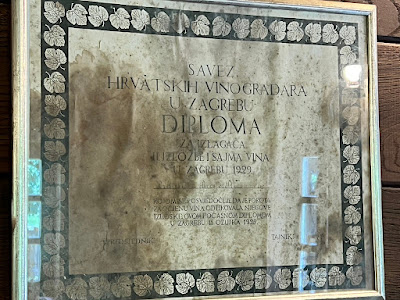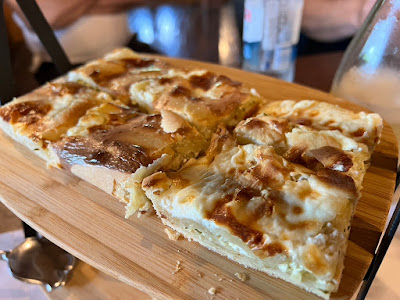If you start your vinous exploration of Croatia in the capital of Zagreb (as I did on my recent trip), then you should next explore the wine region of Plešivica, which is located less than an hour from Zagreb. There is a small village named Plesivica and it provided its name to the wine region as well, which is located on the south side of the Vinjani Hills, near the Cetina River.
Plešivica is a continental wine region comprised of about 2,300 hectares of vineyards and around 40 wineries. Vineyards existed in this region at least since the 14th century. Most of the wineries in this region are small, almost all owning less than 10 hectares of vineyards. The vineyards mostly are planted with international varieties, such as Chardonnay, Pinot Noir, Riesling, Sauvignon Blanc, and Syrah, although you'll find some Austrian grapes as well. About 70% of their vineyards are planted with white grapes, and the grapes commonly have high acidity.
Plešivica is sometimes referred to as "Croatia's Champagne," as the region is famed for its sparkling wines and its calcareous soils resembling those found in the Champagne region. In addition, you'll find some wineries that have been experimenting with the use of amphorae, creating compelling orange/amber wines.
It's a beautiful region, with great natural scenery, and is beginning to boost its appeal to tourists, especially wine tourists. One of the major attractions of the regions is the Plitvice Lakes National Park, which possesses sixteen different lakes, and has various hiking trails through the forests and along the lakes. The park is also filled with many different animals and plants, and even has the largest number of the endangered arctic hares in all of Europe.
Plešivica is a continental wine region comprised of about 2,300 hectares of vineyards and around 40 wineries. Vineyards existed in this region at least since the 14th century. Most of the wineries in this region are small, almost all owning less than 10 hectares of vineyards. The vineyards mostly are planted with international varieties, such as Chardonnay, Pinot Noir, Riesling, Sauvignon Blanc, and Syrah, although you'll find some Austrian grapes as well. About 70% of their vineyards are planted with white grapes, and the grapes commonly have high acidity.
Plešivica is sometimes referred to as "Croatia's Champagne," as the region is famed for its sparkling wines and its calcareous soils resembling those found in the Champagne region. In addition, you'll find some wineries that have been experimenting with the use of amphorae, creating compelling orange/amber wines.
It's a beautiful region, with great natural scenery, and is beginning to boost its appeal to tourists, especially wine tourists. One of the major attractions of the regions is the Plitvice Lakes National Park, which possesses sixteen different lakes, and has various hiking trails through the forests and along the lakes. The park is also filled with many different animals and plants, and even has the largest number of the endangered arctic hares in all of Europe.
During my trip, I visited several of the wineries in Plešivica, and was impressed with what I tasted, from killer Sparkling Wines to delicious Pinot Noir, as well as a few more unique wines. You won't regret visiting this wine region.
Early one morning, our first stop of the day was Vina Josip Braje, situated in the tiny settlement of Lokošin Dol. It's a small winery, with about 5 hectares of vineyards, growing 5 different grapes, and producing approximately 20K-25K bottles annually. They are trying to make their winery more attractive to tourists, including with a restaurant for special dinners. Interestingly, one of their latest problems, which threatens their vineyards, are American crickets, which are fluorescent yellow, and have to be hunted before they can do damage to the vines.
Early one morning, our first stop of the day was Vina Josip Braje, situated in the tiny settlement of Lokošin Dol. It's a small winery, with about 5 hectares of vineyards, growing 5 different grapes, and producing approximately 20K-25K bottles annually. They are trying to make their winery more attractive to tourists, including with a restaurant for special dinners. Interestingly, one of their latest problems, which threatens their vineyards, are American crickets, which are fluorescent yellow, and have to be hunted before they can do damage to the vines.
Back in 1921, the owner's grandfather produced wine, but wasn't selling it legally. It was more a "blackmarket" wine, and their grandfather decided at one point o enter the wine in a competition in Zagreb, curious how the wine would fare against others. His wine was fine enough to win 3rd place in the competition, but the grandfather ran into problems because it was a blackmarket wine, and he ended up spending two weeks in jail. In 1929, he would get a degree from the University of Zagreb (pictured above), and continue producing wine.
Before we started wine tasting, and even though it was still early in the morning, Robert Braje (pictured above) offered us some home-made grappa. We certainly weren't going to refuse such an offer, and got to taste two different grappas. The first was made from local pears, and possessed a pleasing pear flavor, a bit of sweetness, and wasn't too potent. My preference was the second grappa, made from a blend of 70% Blauer Portugieser and 30% Syrah, with the addition of raspberries. It was smooth and delicious, with bright red fruit flavors.
We then started our wine tasting with two Pet-Nat wines. The first Pet-Nat was made from a base of Roter Veltliner, an Austrian grape which I'll discuss more below. This is a more natural wine, using yeast from the vineyard and without the addition of any sulfur. There is sediment in the bottle, making it cloudy in the glass, and it's very fizzy. We were told that the Pet-Nat is produced more for the tourist market as many Croatians see it as "unclean." With a 10.5% ABV, it was light, dry, and refreshing with bright lemon and citrus flavors.
The 2021 Pet-Nat Rosé, made from Pinot Noir, has an 11% ABV, and it too was crisp and dry, with pleasing red fruit flavors and plenty of bubbles. Refreshing and light, it would be a fun summer wine.
As a snack for our wine tasting, Robert's wife, Sandra, made us Soparnik, a Dalmatian speciality which is essentially a savory pie made with Swiss chard and young cheese. This dish has been declared an intangible cultural heritage of Croatia and the European Union has also issued it a protected designation of origin. This soparnik was also made with nettles, and it had a nice, flaky pastry, herbal accents, and was quite delicious.
The 2020 Veltlinac Crveni is produced from 100% Roter Veltliner. You might think this grape is related to Grüner Veltliner, but it's not. Roter Veltliner, which is also known as Roter Muskateller and Roter Reifler (among many other synonyms), is an ancient grape whose parentage is unknown. "Roter" means "red" though the grape actually only has a pinkish tinge and it makes white wine. "Veltliner" refers to the Austrian village of Veltliner. Even though the grape has existed in the Plešivica region for over 300 years, Braje may be the only winery in the Plešivica region currently growing this grape, and it is rare throughout Croatia.
The 2020 Veltlinac Crveni, with a 12.5% ABV, is a white wine, which sees only stainless steel, and which is crisp and dry, with delightful fruity aromas. On the palate, there are tasty flavors of pear and melon, with herbal notes, and good acidity. They believe this wine can easily age for at least ten years due to its acidity. They call this a "summer wine" and it certainly would be excellent as such, but as it would pair well with a variety of foods, this wine would be fine year round. Highly recommended.
The 2021 Pinot Sivi is made from 100% Pinot Gris, and was kept on the less for one month. With a 12.5% ABV, it was crisp and dry, with nice pear and peach flavors, and a rich mouthfeel. Easy drinking and pleasant.
The 2020 Rajnski Rizling, made from 100% Rhine Riesling, has a 12.5% ABV and spent a time in large Slavonian oak barrels. This is a dry-style Riesling, with crisp acidity, citrus and stone fruit flavors, and a backbone of minerality. Definitely my preferred style of Riesling. I would find other Riesling wines during my time in Croatia and most of them were in this style.
The 2018 Pinot Crni, which is made from 100% Pinot Noir, was an eye-opener as I wasn't expecting Croatian Pinot Noir to taste so good. This wine, with a 13.5% ABV, spent about 12 months in Slavonian oak; and had a medium red color with a pleasing nose of fruit and floral elements. On the palate, it was smooth and elegant, with bright and tart cherry notes, a hint of earthiness, and other subtle flavors, creating a more complex taste. It possessed a lengthy, satisfying finish, and overall was a compelling wine. It tasted much more like Burgundy rather than California Pinot. I would taste other excellent Pinot Noir during my time in Croatia, which was quite a surprise. In general, they all were more like Burgundy in style. Highly recommended.














No comments:
Post a Comment